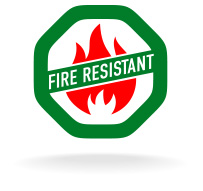How good is flame retardancy?
The major characteristic of SunForce is flame retardancy. Flame retardancy literally means that the material can not burn. Plastics generally burn when in contact with fire. Furthermore, since they are comprised of bubbles of air and readily combustible hydrocarbons, foamed plastics are more readily combustible than other types of plastics.
A foam with good flame retardancy

To ensure that the foam material can be used with confidence as a flame-retardant material, we have developed a plastic composition for SunForce based on a highly flame-retardant PPE plastic as the primary component. Used in combination with a unique microfoaming technology, it provides high flame retardancy despite its properties as a foam.
For example, there is often the danger of short circuits and ignition in electronic equipment and components operating at high temperatures, and materials with a product rating of “flame retardance,” or better are required.
While there are a number of indices for flame retardancy, the UL standard is generally used as the point of reference. This UL standard is a set of optional standards from the UL LLC, private third-party safety science organization in the US, and is also registered in many ANSI standards. It has become the de facto safety standard for electrical equipment etc. In the US, electric products without UL certification are not covered by public liability insurance, and as a result, UL certification has become an internationally recognized representative safety standard.
SunForce is certified as V-0, a very high level of flame retardancy under UL-94, UL's flame retardancy standard for plastics and parts. SunForce achieved a world-first in acquiring the V-0 certification for its foaming beads.
Despite its properties as a foamed material, SunForce is also a molding material usable in components for which flame retardancy is required.
The UL-94 flame retardancy standard also provides for a range of tests and standards.
| Test | Test Details | Standards | Testing of: |
|---|---|---|---|
| (1) Vertical combustion test | 20mm Vertical Burning Test | V-0, V-1, V-2 | Components |
| (2) 5V combustion test | 125mm (5 inch) Vertical
Burning Test |
5VA, 5VB | Cases |
| (3) Horizontal combustion test | Horizontal Burning Test | HB | − |
| (4) Foamed material combustion test | Horizontal Burning foamed
material Test |
HF-1, HF-2, HBF | Shock-absorbing materials |
| (5) Combustion test for thin-walled materials | Thin Material Vertical Burning Test | VTM-0, VTM-1, VTM-2 | Films and sheets |
SunForce is registered in the above (1) Vertical combustion test standard.
A flame retardancy level of V-0 or V-1 under the vertical combustion test is required for internal components of electronic equipment, office automation equipment, battery components, and medical equipment etc. SunForce is usable in such applications.
Since the standard registration also regulates material thickness (see below), it is recommended that it be considered in actual product design.
| Density of molded product (g/L) | Expand ratio | Flame retardancy | |
|---|---|---|---|
| 285 | x3.5 | UL94-V0 | Certified thickness = 3mm or greater |
| 200 | x5 | UL94-V0 | Certified thickness = 3mm or greater |
| 140 | x7 | UL94-V0 | Certified thickness = 3mm or greater |
| 100 | x10 | UL94-V0 | Certified thickness = 5mm or greater |
Furthermore, the (4) Foamed material combustion test standard has been available for some time. Testing conditions are easier than for (1) Vertical combustion test, and when testing HF-1 or HF-2 foamed materials using (1), the material is able to burn completely without self-extinguishing.
In addition to UL standards, SunForce is also certified as “flame retardant” under Material Combustion Tests for Railway Vehicles.
